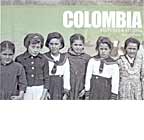Review: COLOMBIA: PICTURES AND STORIES by Sandy Fisher (Colombia)
 Colombia: Pictures and Stories
Colombia: Pictures and Stories
Sandy Fisher (Colombia 1962–64)
Brookview Farm
January, 2011
212 pages
Hardback $60 (autographed) Order from TheMarket@brookviewfarm.com
Reviewed by Lawrence F. Lihosit (Honduras 1975–77)
THIS IS A VISUAL KALEIDOSCOPE of historical images and corresponding stories told by someone who went to serve, then stayed. A member of the second group of Peace Corps Volunteers to arrive in Colombia, Sandy Fisher and 59 other PCVs “sang out the Colombian national anthem (and) Alberto Lleras Camargo, the country’s president, cried.” A half century ago, the world was different and so was the Peace Corps.
Like so many, Fisher was young — 21 — and inexperienced. His first mission was to “develop the community of Tenjo,” a village located in a valley between Andean mountain ranges in central Colombia. He “built a house, cleared a road, rescued machines,” worked on school water systems and helped organize a vegetable cooperative garden. He must have made good friends. A priest attempted to sway opinions against Fisher, but the local townsfolk ignored him. “He’s one of us,” they retorted.
When a Peace Corps coordinator “had to be replaced quickly after an accident,” twenty-two year old Fisher was transferred to Barranquilla, a Caribbean port city with more than one million inhabitants. Then a second-year Volunteer, Fisher was assigned to coordinate 40 Volunteers. This is, of course, inconceivable today just as the measuring sticks of success have changed. During the early Peace Corps years in Latin America, success was measured by construction. “In the first four years of work in Colombia, Volunteers built 44 schools, 27 aqueducts, 200 miles of rural road and over 1,000 latrines.”
Fisher returned home and completed his undergraduate work. Then, he partnered with two other Americans and returned to Colombia to buy a ranch not far from Bogotá. He began a new life as a cattle rancher, road builder and family man. Between 1967 and 1974 he and his new wife literally carved a working ranch from an area which was home to spoonbills, red ibises, white egrets, toucans, macaws, dolphins, eels, leeches, alligators, 250 pound rodents (capybara), snakes, vampire bats and howling monkeys.
But Colombia had already entered its drug-fueled civil war. Rebels had taken over wide swaths of the nation where coca leaf was cultivated. By the early 1970s, some sources estimated that nearly half of all Colombian arable land supported marijuana and/or coca leaf. Gangs formed. The Fishers left after “men with sub-machine guns broke down the door of their Bogotá apartment.” Within six years, a Peace Corps Volunteer was kidnapped, taken hostage and the agency left shortly thereafter in 1981. It only returned last year. In an epilogue, we learn that one of their two Colombian ranches was taken over by “drug gangs and squatters” between 1986 and 1987. Today it is divided into 19 parcels. Fisher and his wife resettled west of Richmond, Virginia where they established a 380 acre cattle ranch and award-winning organic farm.
This book is an example of what patience and a good team can produce. There are maps, nearly 200 photographs and expertly edited text, all printed on 9 by 12 inch sheets, bound old-school style with a stitched binding and protected with a hard cover. The text is in three handsome columns with variations of ink and font sizes between sections and chapters. An art book as well as a memoir, it is a steal and a good reminder that memoirs, like Volunteers, come in all shapes, sizes and flavors. They may be written as one flowing story or, as in this case, in vignettes. Likewise, the style and presentation can vary just as we do. If you are considering to prepare your own memoir, this is a great example of how to gracefully incorporate photos into your story. It also answers all the same basic questions asked in library archival interviews: where you were six months before service, why you joined, what you did, how the place and people were and what happened when you came home. This book is what Goal 3 is all about, sharing.
•
Lawrence F. Lihosit is the author of four books about or inspired by the Peace Corps including: Peace Corps Chronology, 1961–2010; South of the Frontera — A Peace Corps Memoir; Whispering Campaign — Stories from Mesoamerica; and Years On and Other Travel Essays.
Sandy’s decision to return to Colombia and orchestrate a life there illustrates unintended and unexplored consequences of serving in the Peace Corps – a massaging of the soul and an expansion of horizons. He reveals how life in a village in another country unmasks the facade of culture and opens the door to a world of opportunities . . . and risks. His tale is a thread in the shrouded tapestry of the Peace Corps’ 50 year legacy.
Ronald A. Schwarz
Colombia One (1961-63)
Hello Sandy,
Are you the same person that my family, Tom & Ricky Kirby’s, knew in Villavicencio? I thought of you the other day.
I look back on the Colombian days and wonder where people are now.
Cheers,
Rebbie
Wow really fun to come across this! Sandy Fisher was my Dad. What an incredible experience we all had because of the Peace Corps and our beloved Colombia, where my brother Murray and I were born.
Sadly our Dad died a couple years ago, but our Mother Rossie is doing great and I will ask her about Tom and Ricky Kirby. I’m sure she knew them!!
We have so many dear friends and memories of Colombia. It has made our life so incredibly rich. Big thanks to the Peace Corps for that.
Cheers and Gratitude!!
Jane Fisher
I had the privilege of meeting your parents in Washington D.C. during the 50th celebration. My best regards to you and your family.